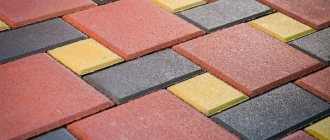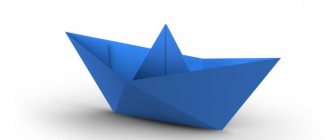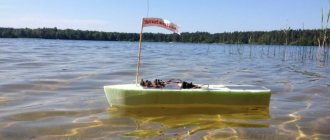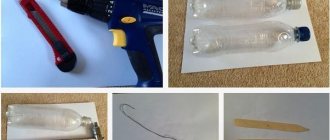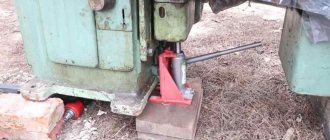The concept of “tuning” means improvement, modification or modernization of a product.
In this case, the modification of the PVC boat. Large-scale “tuning” of such boats costs a lot of money, especially since it involves improving the design or individual elements of the PVC boat design. The reason for modernizing a floating craft can be various factors. The first factor includes its imperfect appearance, associated with the purchase in “ancient” times, when few people thought about the perfection of the product. The second factor is very serious and is related to the financial side of the matter. People buy inexpensive things with the hope that they will improve them without spending a lot of money. In addition, modernization can be carried out gradually, which will not lead to immediate costs. At the same time, it should be remembered that during the refinement process it is better to install only the necessary and useful elements that improve the characteristics of the product. Although, everyone has the right to decide which innovations are suitable for a floating craft.
Many elements can be purchased and installed on the boat. You don’t have to make them yourself, especially since this process can take time.
Bottom reinforcement
The PVC fabric that serves as the bottom of the boat is quite durable, but it is inconvenient to move on. Since the bottom is not hard, every angler experiences a number of inconveniences. Therefore, strengthening the bottom is the primary task. In the future, the reinforcement will have to be repaired, but not the bottom of the boat. This will cost less, and it will be easier to replace the reinforcement with a new one or repair it. It is possible to carry out both full and partial reinforcement of the bottom of the boat.
The bottom is reinforced by gluing a special PVC tape, which is called a “fender bar”. The fender can have a thickness of 1.2-3 mm with a width of 60-235 mm. It is attached using 2-component glue. This will make the bottom harder and more protected from various underwater surprises.
Keel reinforcement
The operation boils down to gluing PVC tape (fender) over the factory tape. Similar reinforcement extends to the keelsons.
Strengthening cylinders
Reinforcement is carried out based on need. Cylinders are also subject to constant wear and tear.
Transom reinforcement
For this element of the boat, reinforcement is simply necessary, since the transom is protected by only one layer of PVC fabric.
In order not to suffer with individual elements, the bottom of the boat can be completely sealed using a fender. If you are careful and careful, and also choose the right glue, you can do the operation yourself. This approach will solve many problems associated with the deterioration of the boat’s performance.
Installation of stringers
If the boat has a hard floor, you will have to install duralumin profiles. Since the boat is deformed while moving, the hard floor pads touch the inflatable parts of the boat and a friction process occurs. This can lead to abrasion of the fabric, which is undesirable and can compromise the strength of the boat. In the bow, where the profile of the boat has a curved shape, stringers are not installed.
Simple DIY design
If you decide to make such a product for yourself, you will probably take the work seriously. Take a sheet of plywood 1 cm thick.
The manufacturing algorithm is as follows:
You need to cut four parts from plywood. Transfer the dimensions from the drawing that you prepared in advance. Apply a circle with a radius of 19 cm to the workpiece, this is provided that the diameter of the cylinder is 38 cm. Cut out the part along the applied contour. Attach it to the cylinder of your boat, make a kind of fitting. Make two parts that are identical to each other. Please note that the battery will be installed inside them in the future. Connect the two shelves together, as well as the battery
Use previously prepared fasteners. It is worth making recesses on top of the structure being manufactured. This is important to do. So that in the future you will be able to hide all the wiring in them, and this is important at least for your comfort. Make recesses in the upper part of the product
Their purpose is to move the structure along the length of your boat. Make a hole in the center so you can attach the stand for the echo sounder. Install the structure you assembled yourself.
That's the whole fairly simple process of making a table yourself.
Self-attachment of the fender beam
Independent strengthening of a PVC boat consists of the following operations:
- The boat is washed, after which all dirt is removed. After this, the boat is dried as thoroughly as possible. It should be remembered that the slightest traces of moisture will not allow the elements of the boat to be properly glued together.
- The surfaces to be bonded are degreased with gasoline or acetone. Degreasing is carried out carefully so as not to disturb the fabric.
- Using a brush, a layer of glue is applied to the surface. Typically the adhesive is applied to the boat and fender. After 15 minutes, a second layer of glue is applied. The layers dry until the glue stops sticking to your hands.
- The beam is placed on the surface and pressed.
- To ensure that the surfaces stick securely, it is better to heat them with a hairdryer. Heating is carried out very carefully so that the plastic does not start to melt.
- After this, the surfaces to be glued are again pressed with maximum force.
Installing a fender with a scallop on a boat
Spinning rod holders
A very useful accessory. Special fasteners can be purchased at the store. The optimal option for one is 2 fastenings, for two – 3 fastenings. Excessive fastenings can be a hindrance. It is not advisable to have a large number of spinning rods in ready condition. If necessary, they can be pulled out of the tube at any time.
Alternatively, you can make rod holders yourself from PVC pipes. They can be easily purchased at hardware stores.
DIY fishing rod holder
Transom wheels
It is very difficult to live without this important device. It can be very difficult to transport a heavy inflatable boat to the water with your own hands; in this case, wheels will help us.
As a base for fastening the wheels, you can use strips 20 cm wide, which are cut from a plastic barrel; the wheels can be fastened using bolts.
This design is secured to the cylinders using fasteners, and if necessary, you can easily dismantle them. This simple tuning will allow you to avoid many of the inconveniences associated with transportation.
Find information about electric motors for inflatable boats here. We recommend that you familiarize yourself with the features of choosing a pump for PVC boats.
boatcity.ru
Inflatable keel
As a rule, simple boats are not equipped with a keel, which does not allow it to stay on course. If you install an inflatable keel on it, this will help solve the problem of boat stability, especially in the presence of waves.
The size of the keel depends on the length of the boat. If you install a keel on a boat that is less than 3 meters long, this will cause the bow of the boat to rise. This element is attached using special ribbons, which are included in the package.
Main types of anchors
The entire group of anchors can be divided into three subgroups:
- gravitational;
- floating;
- clinging to the bottom.
The gravity option includes simple and very practical anchors to use. For example, cast iron disks, stones, knitted bricks, bags of silt, pancakes from a barbell, homemade lead options, tracks from a tank or tractor. Such anchors lie flat on the bottom and perfectly hold the boat on the water. The disadvantage of such options is their bulkiness and heavy weight.
The floating option is also called a parachute. This name fully corresponds to its design. This option is great for reservoirs without current. The parachute reliably holds the boat even in strong winds. To make this parachute, high-quality polyethylene or fabric is used. The design of the parachute anchor is very simple. The diameter of the parachute and the length of the lines are 1.5 meters. This product is attached to a 10 meter long rope. In the center of the parachute circle it is necessary to make a hole with a diameter of 10 cm for water to escape.
The clinging options are based on the presence of paws that cling more reliably to the river bottom. The legs in such anchors can be very diverse - from thin wire to wide flat ones. As a rule, such products are equipped with various hinge units with moving components. The use of this type of anchor makes it possible to reduce its weight and use compact modifications.
Anchor Cat
The most popular clinging type anchor is the cat anchor. Many anglers modify the cat, giving it more versatile characteristics. In particular, you can reduce snagging by tying a rope to it from the paw side. To prevent sharp paws from injuring the PVC, they can be rounded. Typically, a grapple anchor has a collapsible design, which is very convenient, especially when used with a PVC boat.
You can make an anchor that will be an analogue of a cat yourself. To do this you will need the following components:
- a piece of pipe with a diameter of 2.5 cm and a length of 30 cm;
- two metal plates up to 30 cm long and up to 10 cm wide;
- nut and two rings
- lead.
The components and the entire product assembly are shown in the photo. For safety, it is better to round the corners. If necessary, the paws can be bent. Lead is required to be poured into the pipe. This way the manufactured anchor can be loaded to the required weight. This product is convenient to use for searching for sunken objects.
Hall anchor and Danford anchor
One of the popular and widely known options in shipping is the Hall anchor. As a rule, the parts of this model are cast from cast iron and have a hinged structure. The holding force of such a product is 3-4 times greater than its weight, so this model is even used for boats.
More modern and easier to make is the Danforth anchor, which is a bit similar to the Hall anchor. You can make an analogue of such an anchor that is suitable for inflatable boats yourself. The picture shows a homemade analogue of the Denford anchor.
Despite its great popularity, such an anchor is not very practical. The plane of its contact with the bottom is not very large and such a product can be carried in a strong current. Therefore, this option is applicable when used on the bottom with soft soil, where it will have the opportunity to burrow.
Mushroom anchor
One of the best options for fishing in currents is a mushroom-shaped anchor. This version of the anchor provides the best adhesion to the bottom soil thanks to the mushroom cap, which burrows into the ground when the rope is pulled . Typically, such anchors are cast entirely.
At home, something like a mushroom-shaped anchor can be cast from lead. Another possible option is a homemade product from a frying pan. A DIY frying pan anchor is an excellent homemade option that is perfect for a PVC boat. It is made very simply:
- a thread is cut on one side of a steel rod with a diameter of 1-2 cm;
- on the other side, a hole is drilled for threading the rope;
- a hole is drilled in the center of the frying pan for this rod;
- the rod is screwed to the frying pan with a nut.
The greatest deterrent effect can be achieved when using an anchor of this type - the stronger the current, the more it burrows into the ground.
Seats
Almost all models of such boats are equipped with hard seats, which is not very comfortable, since you have to sit in one place a lot. To make fishing a joy, it is better to replace the seats with soft ones or modify the old ones. Most boat owners build ice fishing style seats with a storage box underneath the seat.
Alternatively, you can design a movable seat that can be installed at any point.
Homemade wooden boat
Wood is the most common and favorite material for boats among fishermen.
And it’s not just that, boats made of wood are the most durable and feel good afloat, they are made from environmentally friendly materials and do not consume a lot of natural resources.
With proper operation and proper, good storage, a wooden boat can serve you for quite a long time.
Outboard motor insurance
Fishing is an interesting, but also dangerous activity. Sometimes it's hard to predict what might happen while fishing. Quite often, when emergency situations intervene during the fishing process, the motor fails. As a result, the motor simply goes under water. To prevent this from happening, the motor is insured using a steel or artificial cable. It is attached to the transom through 2 eye rings. In other words, the motor is simply tied down.
Fuel tank mount
Elements such as an additional gasoline canister require mandatory fastening. This is necessary so that when moving or making sharp turns the canister cannot change its location. Fastening is carried out by means of a rope and half rings attached to the boat. They are attached to the boat as follows:
- half rings are glued to the bottom if it is made of PVC fabric;
- screwed to the floorboards with screws if the floor is hard.
Materials for production
If you have ever seen various videos on how to make a boat, then you may have noticed that a lot of materials are used for this and they are all different.
We will list only the main ones and tell you about each in more detail.
- Wooden boats.
- Rubber boats.
- Aluminum boats.
Fasteners
All additional elements are attached to the PVC boat using two-component glue. There are several models of universal fastening systems. If you install it, then you can adapt any elements to it.
Fastener "nickel"
A universal fastening element designed for fastening fishing rods, awnings, tables, etc. The main material for its manufacture is PVC. The dimensions of the “penny” fastener are height 35 mm, diameter 20 mm.
Aluminum boat
Aluminum boats differ from others in their reliability and durability.
The main disadvantages, because of which fishermen do not use this material much, are that aluminum is quite expensive and very difficult to get.
And also, manufacturing takes much more time than making boats from other materials, so if you need a strong, high-quality and durable boat, then it’s better to take a closer look at the wooden option. This will save you time and money.
